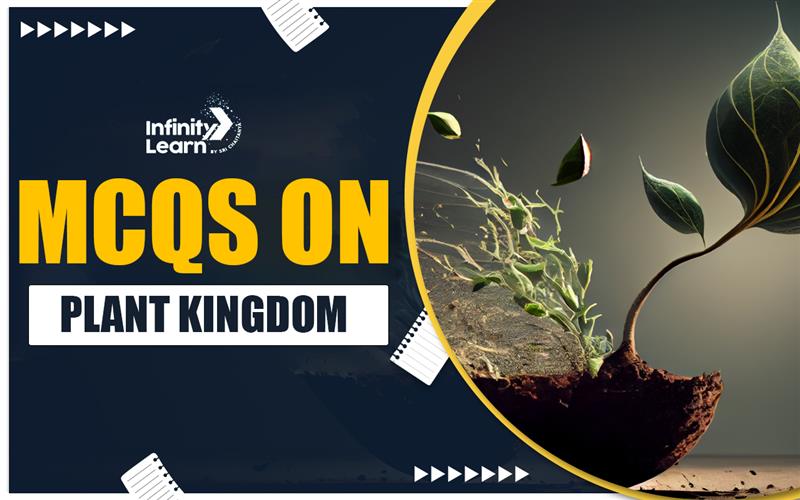Table of Contents
The Plant Kingdom is a fundamental chapter in Class 11 Biology, providing a comprehensive understanding of the classification and characteristics of the plant world. It’s an important topic for exams like NEET, JEE, and CBSE Board exams, frequently featuring in MCQs. Here, we present topic-wise multiple-choice questions (MCQs) to strengthen your preparation.
MCQs on Plant Kingdom

General Characteristics of the Plant Kingdom
- Which of the following is not a characteristic of plants?
-
- (a) Autotrophic nutrition
- (b) Cell wall made of cellulose
- (c) Presence of chitin in the cell wall
- (d) Storage of starch as food reserve
Answer: (c) Presence of chitin in the cell wall
-
- Cryptogams include:
- (a) Algae, Bryophytes, and Pteridophytes
- (b) Gymnosperms and Angiosperms
- (c) Monocots and Dicots
- (d) None of these
Answer: (a) Algae, Bryophytes, and Pteridophytes
Algae
- Which of the following algae is used as a biofertilizer?
- (a) Ulva
- (b) Nostoc
- (c) Laminaria
- (d) Polysiphonia
Answer: (b) Nostoc
- Brown algae store food in the form of:
- (a) Laminarin and mannitol
- (b) Starch and glycogen
- (c) Oils and lipids
- (d) Glucose and sucrose
Answer: (a) Laminarin and mannitol
Bryophytes
- The dominant phase in the lifecycle of bryophytes is:
- (a) Sporophyte
- (b) Gametophyte
- (c) Zygote
- (d) Spore
Answer: (b) Gametophyte
- Which among the following is a liverwort?
- (a) Marchantia
- (b) Funaria
- (c) Lycopodium
- (d) Equisetum
Answer: (a) Marchantia
Pteridophytes
- Pteridophytes differ from bryophytes in having:
- (a) Non-vascular tissues
- (b) Vascular tissues
- (c) Heterosporous lifecycle
- (d) All of the above
Answer: (b) Vascular tissues
- Which of the following is a homosporous pteridophyte?
- (a) Selaginella
- (b) Salvinia
- (c) Lycopodium
- (d) Marsilea
Answer: (c) Lycopodium
Gymnosperms
- Gymnosperms are characterized by:
- (a) Presence of flowers
- (b) Naked seeds
- (c) Fruits with seeds
- (d) Double fertilization
Answer: (b) Naked seeds
- Which gymnosperm has a symbiotic relationship with cyanobacteria?
- (a) Ginkgo
- (b) Cycas
- (c) Pinus
- (d) Ephedra
Answer: (b) Cycas
Angiosperms
- Double fertilization is unique to:
- (a) Algae
- (b) Bryophytes
- (c) Gymnosperms
- (d) Angiosperms
Answer: (d) Angiosperms
- Monocots differ from dicots in:
- (a) Presence of vascular bundles
- (b) Parallel venation
- (c) Presence of flowers
- (d) Root system
Answer: (b) Parallel venation
Alternation of Generations
- Haplo-diplontic life cycle is exhibited by:
- (a) Fucus
- (b) Funaria
- (c) Spirogyra
- (d) Chlamydomonas
Answer: (b) Funaria
- The sporophyte is dominant in:
- (a) Algae
- (b) Bryophytes
- (c) Gymnosperms
- (d) Fungi
Answer: (c) Gymnosperms
Diagram-Based MCQs
- Identify the labeled parts in the lifecycle diagram of a fern.
- (a) Sporangium
- (b) Prothallus
- (c) Archegonia
- (d) Antheridia
Answer: (b) Prothallus
- The structure labeled as ‘X’ in the diagram of a flower represents:
- (a) Stigma
- (b) Ovule
- (c) Petal
- (d) Anther
Answer: (a) Stigma
Assertion-Reason MCQs
- Assertion: Bryophytes require water for fertilization.
Reason: Male gametes are flagellated and motile.- (a) Both Assertion and Reason are true, and Reason is the correct explanation.
- (b) Both Assertion and Reason are true, but Reason is not the correct explanation.
- (c) Assertion is true, but Reason is false.
- (d) Both Assertion and Reason are false.
Answer: (a) Both Assertion and Reason are true, and Reason is the correct explanation.
Previous Year Questions (PYQs)
- Which of the following algae is used for iodine extraction?
- (a) Fucus
- (b) Chlorella
- (c) Ulva
- (d) Laminaria
Answer: (d) Laminaria
- In which of the following plants are archegonia absent?
- (a) Funaria
- (b) Cycas
- (c) Pinus
- (d) Vallisneria
Answer: (d) Vallisneria
Tips for Solving Plant Kingdom MCQs
- Focus on distinguishing features of algae, bryophytes, pteridophytes, gymnosperms, and angiosperms.
- Pay attention to lifecycle diagrams and examples.
- Practice assertion-reason questions to build conceptual clarity.








